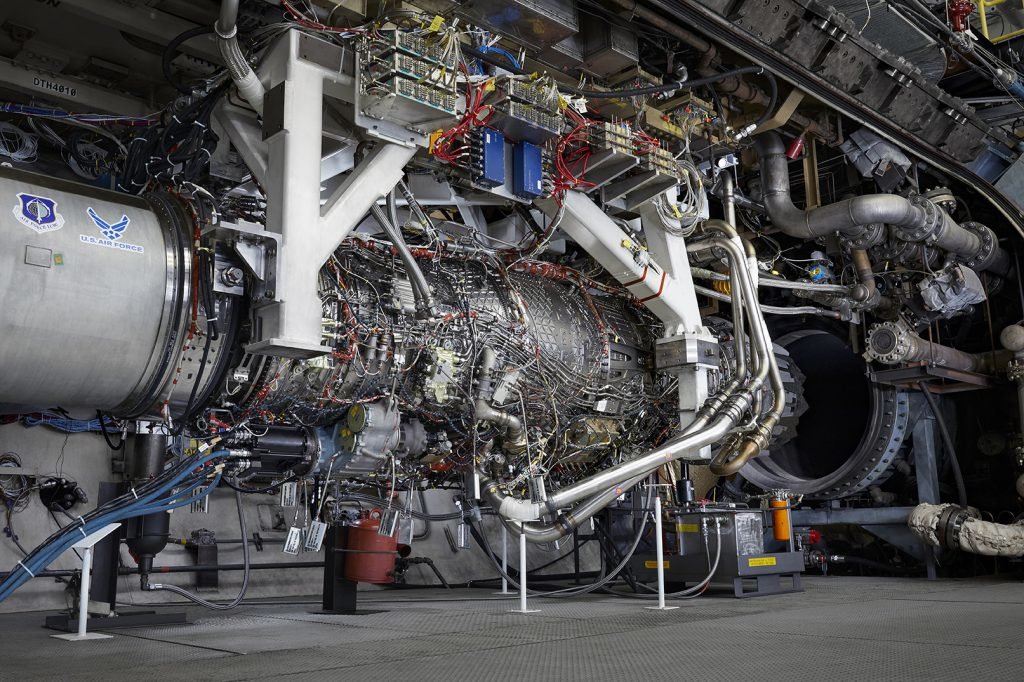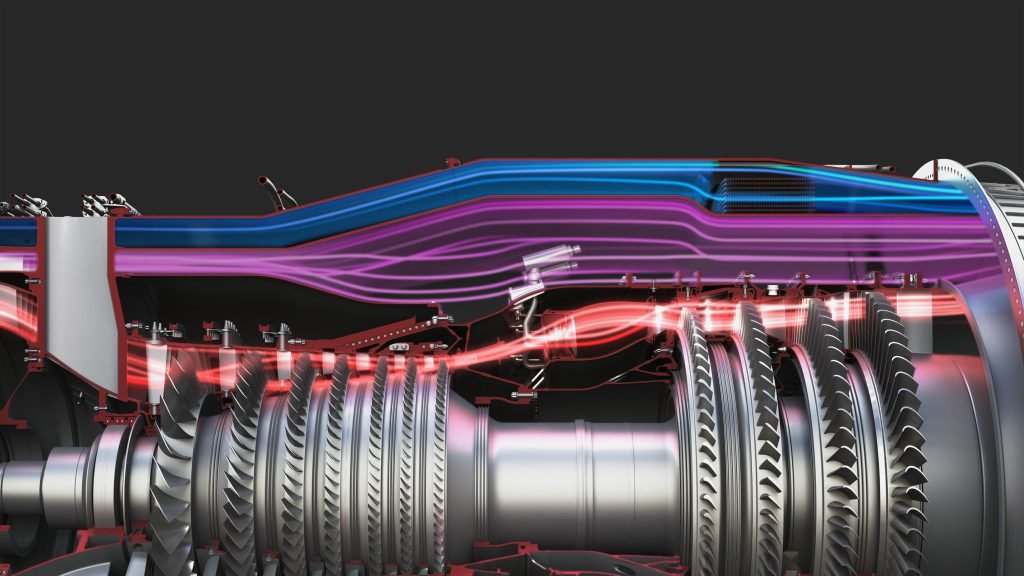
This article was originally published May 14, 2021, on Sandboxx News. Follow Sandboxx News on Instagram.
GE just completed its initial test runs of the first full-scale XA100 three-stream adaptive combat engine–an entirely new fighter power plant that promises to give the United States a distinct advantage in the skies of the 21st century. Fighters have always had to maintain a tightrope walk between unleashing the power of their engines and saving enough fuel to be effective in a fight. With GE’s XA100, that’ll get a whole lot easier.
The first full-scale XA100 is one of two technology demonstrators contracted to GE through the U.S. Air Force’s Life Cycle Management Center’s Adaptive Engine Transition Program (AETP), with elements of development handled through both the Adaptive Versatile Engine Technology (ADVENT) and the Adaptive Engine Technology Development (AETD) programs.
This first demonstrator was intended to not just offer an incredible amount of power, but a huge improvement in engine efficiency that can grant greater fuel range and longer loiter times than ever before.
“The goal for the Air Force was to develop the next-generation fighter engine architecture and technologies to provide a generational step-change in combat propulsion capability,” David Tweedie, GE Edison Works’ General Manager of Advanced Combat Engines, told Sandboxx News.
“GE has worked hard to achieve the challenging objectives the Air Force has set out, and we believe we are delivering on what they’ve asked us to do.”

And deliver they did. GE tested their XA100 at their high altitude test cell in Evendale, Ohio over the span of more than three months, starting at the tail end of 2020, and according to their reports, the engine actually exceeded their performance targets. Chief among their goals was successfully demonstrating the engine’s ability to operate in both a high-thrust mode that delivers unparalleled power in combat and a low-burn mode that allows for covering greater distances or remaining airborne for extended periods of time.
“We hit all of our primary test objectives,” Tweedie told Aviation Week. “The engine behaved right along with our pre-test predictions and was very consistent with the program goals. We were able to demonstrate the two different modes of the engine and the ability to seamlessly transition between those two modes.”
The aim of GE’s XA100 engine was to increase thrust by 10% and fuel efficiency by 25%, but in testing, the engine did even better than that.
“Not only are we meeting that, we’re actually exceeding that pretty much everywhere in the flight envelope—and in a few places—up to 20% [more thrust],” Tweedie said. “We are very happy with where we are from thrust in terms of over-delivering versus the program requirement.”
“When you translate that to what it means to the platform, it’s 30% more range or 50% more loiter time depending on how you want to utilize that fuel burn improvement. It’s a significant increase in acceleration and combat capability with the increased thrust,” he added.

American combat aircraft are already renowned for their powerful and efficient engines. China and Russia both have new fifth-generation (stealth) fighters in service, but both nations continue to struggle with fielding engines that are adequate to meet the performance needs of top-tier fighters in the 21st century. However, China claims to be nearing development on their WS-15 engines that were specifically designed to bring their Chengdu J-20 stealth fighter on par with America’s F-22, threatening to erode that advantage.
GE’s new XA100 can produce a whopping 45,000 pounds of thrust, edging out the Pratt and Whitney’s F-135-PW-100 that currently powers America’s single-engine F-35 Joint Strike Fighter and making it a viable option for the conventional-runway iteration of the jet, the F-35A. This news comes amid ongoing concerns about F-35 engine availability and maintenance issues that could threaten as many as 20% of F-35s if a resolution isn’t found soon. While GE’s XA100 would not enter service in time to address these shortfalls, the new engine shines a light on the concept’s promising future, as well as other potential applications for this engine that span three fighter generations.
“The ADVENT, AETD, and AETP programs were set up to mature the technologies from both a design and manufacturing perspective and to burn down program risk to enable multiple low-risk Engineering and Manufacturing Development (EMD) programs that could be applied to legacy, current production, and future fighter aircraft platforms,” Tweedie explained to Sandboxx News.
That part about “legacy, current production, and future fighter aircraft programs” is particularly important as the United States Air Force continues to hash out how best to approach the problem of airpower in this new era of near-peer competition. The F-35, once intended to serve as the backbone of the U.S. Air Force for decades to come, now faces renewed criticism over operational costs that threaten the program’s supremacy on the Air Force’s budgetary priority list.
Meanwhile, older fighters like the F-15 have returned to prominence through significant upgrades, with the F-15EX Eagle II making its way into service. And like the Air Force, the U.S. Navy is also doubling down on their legacy fourth-generation platforms, taking deliveries on the first new Block III Super Hornets last summer.
Not to keep too much focus on the past and present, however, the Air Force and Navy are also continuing their hushed development on the NGAD fighter program that promises to yield America’s next air superiority platform, which some believe will be the first of a sixth-generation of fighters. All told, that means the United States will likely be operating three different generations of fighters simultaneously within the coming twenty years. While fifth and sixth-generation platforms will offer the greatest survivability in highly contested airspace, fourth-generation jets would also benefit from an increase in power and efficiency, making the world’s most capable 4th-gen birds even morecapable.
Importantly, however, that additional capability won’t come with extra stuff for the pilot to keep track of. In recent years, the Pentagon has devoted huge swaths of funding to limiting the cognitive loadon fighter pilots during combat operations, streamlining their interface with the aircraft’s controls, and fusing data to offer pertinent information in the pilot’s line of sight. In keeping with this concept, GE’s XA100 handles the transition between modes without any need for pilot input.

“The mode transition is seamless to the pilot, and they won’t even know when it happens,” Tweedie told Sandboxx News. “They will control engine power using the throttle the way they always have, and the engine schedule will determine the appropriate operational mode.”
But the XA100 isn’t just a big deal because of its fuel efficiency and power. While this new engine’s ability to seamlessly transition between tearing through the sky like a top fuel dragster and minding the fuel gauge like a Toyota Prius might catch the attention of aviation enthusiasts, it might be the engine’s thermal management and use of advanced component technologies that really make the XA100 a leap forward in fighter engines.
According to Tweedie, the XA100’s “three-stream architecture” enables a doubling of thermal management capacity, or in other words, a real reduction in the heat created by the engine’s operation. That heat reduction is essential as modern aircraft shift away from traditional metal airframes and fuselages and toward more advanced composite materials. Heat is currently a limiting factor in power production, but that will no longer be the case with this new generation of powerplant.
“We see a significant increase in capability there [with] up to two times mission systems growth enabled by the [improved] thermal management,” Tweedie said.
Advanced component technologies including additive and Ceramic Matrix Composites leveraged in the XA100’s design also play an important role in what makes this new engine stand head and shoulders above previous power plants. Not only does this reduce the overall weight of the engine, it also increases its durability over previous designs.
The result combination of power, fuel efficiency, heat management, and resilient but lightweight construction make the XA100 the physical embodiment of a fighter engine wish-list. While any of these improvements in capability would be welcome in most fighter designs, the collection of them in a single system could well make for a power plant that is even greater than the sum of its parts.
And with nations all over the world hurriedly developing new fifth and sixth-generation fighters, the United States will need every advantage it can muster to retain the competitive edge.

Coffee or Die is Black Rifle Coffee Company’s online lifestyle magazine. Launched in June 2018, the magazine covers a variety of topics that generally focus on the people, places, or things that are interesting, entertaining, or informative to America’s coffee drinkers — often going to dangerous or austere locations to report those stories.
BRCC and Bad Moon Print Press team up for an exclusive, limited-edition T-shirt design!
BRCC partners with Team Room Design for an exclusive T-shirt release!
Thirty Seconds Out has partnered with BRCC for an exclusive shirt design invoking the God of Winter.
Lucas O'Hara of Grizzly Forge has teamed up with BRCC for a badass, exclusive Shirt Club T-shirt design featuring his most popular knife and tiomahawk.
Coffee or Die sits down with one of the graphic designers behind Black Rifle Coffee's signature look and vibe.
Biden will award the Medal of Honor to a Vietnam War Army helicopter pilot who risked his life to save a reconnaissance team from almost certain death.
Ever wonder how much Jack Mandaville would f*ck sh*t up if he went back in time? The American Revolution didn't even see him coming.
A nearly 200-year-old West Point time capsule that at first appeared to yield little more than dust contains hidden treasure, the US Military Academy said.












